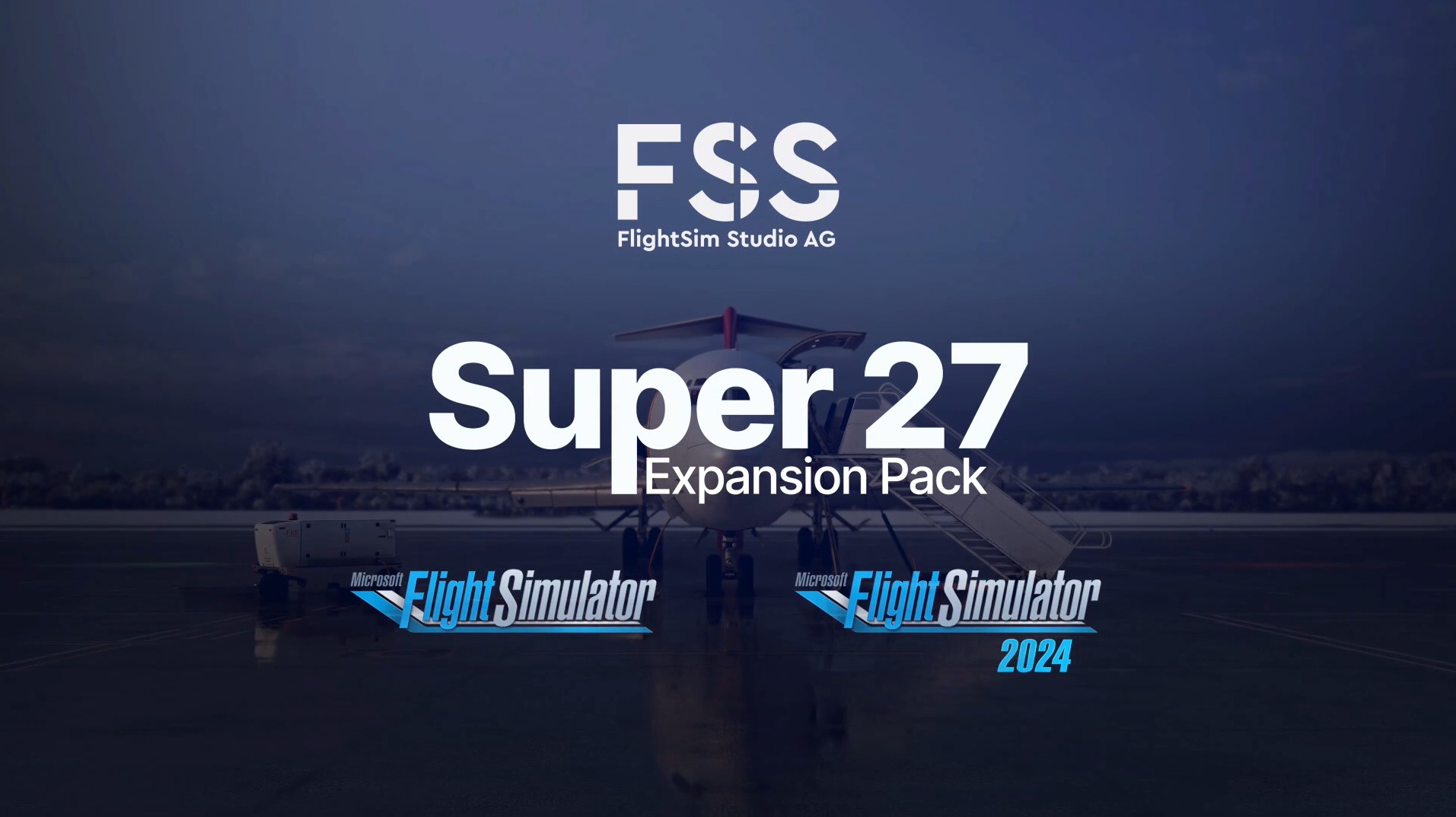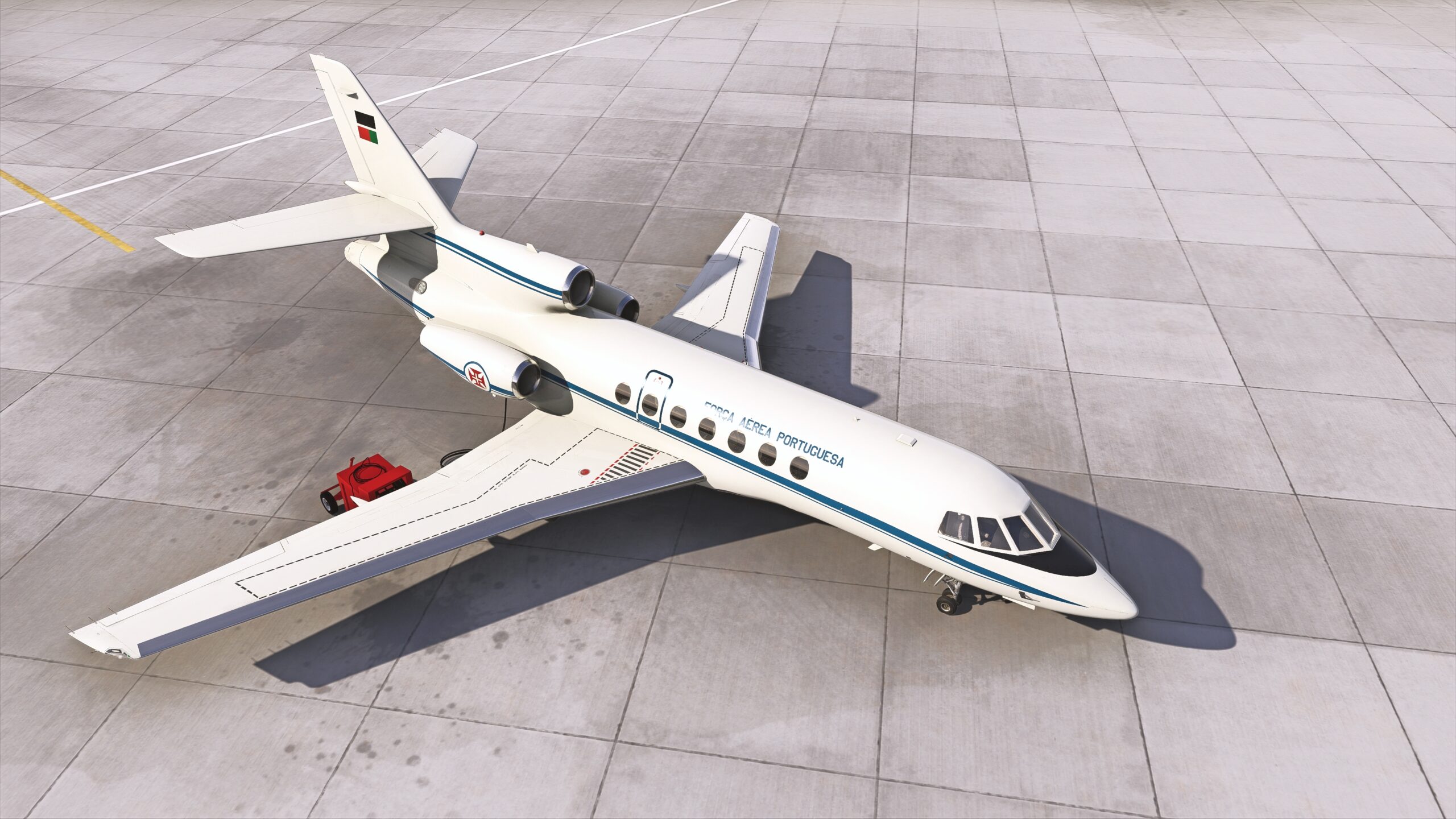As the one-year anniversary of the release of FlightSim Studio’s E-Jet Lineup approaches, let’s take a look at the progress made since its initial release. We’ll review the product and discuss its various shortcomings and flaws before discussing the improvements made since the release and where the product needs to be taken next.
The release of FSS’s E-Jets was controversial, to say the least. The developers at FSS were no doubt excited about the release of their new flagship product. The E-Jets received some phenomenal release teasers, aided by the MSFS videography mastery of the AviationLads YouTube channel. Hype for the aircraft was so incredibly intense the amount of support that FSS garnered in early access purchases (myself included) is likely carrying the project to this day. Unfortunately for the FSS E-Jets, instead of becoming a success story, it became the story of an overhyped community, an underdelivering product with a committed developer, and a herculean effort to deliver on initial promises.



Review Setup
As always, to ensure we all understand the context and conditions under which the review took place, I will review the basics of my flight simulation setup and a little on my flight-simming background. I undertook flight simulation as a hobby in early 2020 with MSFS 2020 on an Xbox One S and a controller. Since then, I have upgraded to a desktop PC and various flight simulation peripherals. I have extensive experience working in a large international airport’s senior engineering management team, giving me a unique behind-the-scenes viewpoint of all things aviation.
The hardware used for this review includes the Honeycomb Bravo Throttle Quadrant and Thrustmaster Airbus replica flight control stick. At the time of writing, I do not have rudder pedals and used the yaw axis on the Airbus replica stick for rudder and tiller control. My PC falls under mid-tier specs with an RTX 3060, Intel i5-11400F, and 64GB of RAM. I use a 1440P, 75Hz curved monitor with a Tobii Eyetracker 5 for extended visibility. I purchased the copy of the FSS E-Jets as a pre-order for early access, and was not sponsored or endorsed by FlightSim Studio. This review contains my honest opinions and is not influenced by any external entity.
This review is based on the most up-to-date version of the E-Jets as of writing (0.9.18).
Build-up to Release
The build-up to release is as important, if not more important, than the release itself. Building community hype and engaging community figures, such as YouTubers and Streamers, is a popular and effective way to drive pre-orders and traffic for the final release. The FSS E-Jets family did this exceptionally well – some might say too well, considering how the product was received – pushing excellent teaser videos and even giving some early-build products out to popular streamers and YouTubers. The highlight of these, and what sold me on the pre-order, were the videos released by AviationLads over on YouTube. These videos sparked my initial excitement for the project and led to me following development closely.
I was immensely excited about this project. I had the FSS homepage open in a tab on my PC permanently. I would refresh the page every day, hoping for new news. When the release date announcement came around, I was buzzing with excitement. I had never been this excited about a videogame release or any other digital product. This may explain my naivete when it came to the definition of “early access” and how those two words would become the defining principles of this product at release, after release, and even now.

That was not to say that the developer was not open about the product releasing in early access. It was that I did not fully understand what early access meant. As the news flowed from FlightSim Studio, they were clear that many features that flight simmers are used to were not completed. They were not clear on just how not complete they were. In my mind, the excessive hype was not the downfall of this product; the lack of complete transparency on the state of the product was.
Release and Initial Impressions
… were bad. I genuinely have no other words to describe how poorly this product was released to the public. All the videos, public demonstrations, and live streams used as promotional material hid how unfinished this product was. It is an understatement to say that this product was not ready for release. It was several more months of development early.
Upon loading up the aircraft for the first time, you are presented with a changelog screen. I appreciate that; it’s a nice and quick way to see what has been fixed and whether issues that you had come across were addressed in new updates. This also turns out to be great reading material. Running through the list in my most recent bootup, you can spend half an hour catching up on all the changes since release.
I was incredibly excited about the release of these E-Jets. At the time, I was hooked on short-range regional hops but didn’t have the right tools to do them satisfactorily. There were lots of great narrowbody options; they’re just not realistic for a regional hop from John F. Kennedy to Washington Dulles or Portland to Seattle. I was excited for the opportunity to realistically simulate regional hops on aircraft designed and built for this purpose.
The State of the E-Jets on Release
As previously alluded to, the release of the FSS E-Jets was a bit of a dumpster fire. The product was released with only the E175 model; admittedly, at release, the external model was the aircraft’s strongest feature, and to this day, in many ways, it remains the element I like most. I can’t say that there was much competition at release in terms of strong feature implementation.
Examples of things that were missing on release:
- APU Sounds
- Vertical Profiling
- Autopilot Sourcing
- Fire Detection System Tests
- Waypoint Sequencing
- PFD Marker Beacons
- Takeoff Trim Calculations
- Custom Autothrottle
- Thrust Rating System
- Rain Effect
- AP Overspeed Protection
- Vertical Speed Callouts
- Approaching Minimums Callouts
All of those features were eventually implemented, many taking months to almost a year. There are still many features that are missing. I find some of these missing features rather baffling, as though they should’ve been included in the release.
Examples of things still missing:
- VNAV
- Aircraft State Saving
- Pitch Limit Indicators
- Steep Approach Mode
- ARC and MAP Mode for HSI
- Holding Procedures in MCDU
- Speed/Altitude Constraints
- Autopilot Bank Limits
- Landing Gear Aural Warning
- Engine Fire Handle Simulation
- AP Back-Course Mode
- Go Around Flight Director
As we approach the one-year anniversary and this product still doesn’t have a custom VNAV or even holding procedures programmed into the MCDU, it is concerning and extremely underwhelming. This goes without saying: overpromising and underdelivering are as harmful to your image as just releasing a poor product. Fortunately, FlightSim Studios has worked tirelessly to improve their E-Jets. Let’s continue to the review section and discuss the many features that I do appreciate and at what point in development I will be comfortable recommending this product.


The Good
This section of the review primarily focuses on good features onboard FSS’s E-Jets. However, most of these features are heavily interlaced with other features that are lackluster at best. Oftentimes, features are halfway to where I would like them. The bar for being in “the good” section is rather low.
The External Model
Starting off with the FSS E-Jet’s strongest feature, the external model. The model on this aircraft add-on is simply superb. I have spent some time on the ground around these aircraft, and I can confidently state that no other E-Jet add-on has captured the physical presence of these jets as well as FlightSim Studio’s E-Jet has. Praising the external model comes with a heavy caveat: X-Craft’s studios originally developed the model for their E-Jet add-ons in X-Plane.



Credit where credit is due, X-Crafts has done a phenomenal job on this aircraft. However, FSS is responsible for porting it to MSFS, and they have done so expertly. Even though the model is technically identical, the aircraft simply looks leagues better in MSFS than it ever has in X-Plane. There are details in this model that nobody would notice if they hadn’t spent time up close and personal with the aircraft itself.


My favorite element of the external modeling has to be the ridging surrounding the wing root. Take a closer look at the joint between the wing and the fuselage of the aircraft. Notice the intricate edges and ridges that have been sculpted to the airframe. I have never seen that level of detail in an aircraft. Even some of the very best – PDMG and Fenix – don’t capture me the same way as this model does. Simply superb.
Cockpit Modeling and Textures
These are overall very strong. I have not spent too much time inside the cockpit of these aircraft, so I can’t reliably tell you that it is as one-to-one as the external modeling is. Looking at reference images and from what I remember, it feels really well modeled. I emphasize modeling because the texturing is not on the same level.


The texturing in the cockpit is passable. Some touch-ups here and there would elevate the cockpit experience to a whole new level. The textures are plasticky and very flat. I also have a massive pet peeve with non-weathered cockpits. I have never set foot into an aircraft cockpit that didn’t look like it had been the location of at least two crime scenes. This is an exaggeration, of course; however, these aircraft get abused. They fly thousands of miles every day, and the cockpits wear heavily.
At the end of the day, we are all piloting behind a screen using simulation hardware that’s meant to get us as close as possible to the real cockpit. Part of the broader equation to successfully do that is the ability of the aircraft we are flying to immerse us. The flight simulation standard has been raised so high simple things such as convincing cockpit weathering are now expected by flight simmers. As such, I find myself struggling to be fully immersed in this cockpit.

Overall, the cockpit gets a pass for its excellent modeling. Even though the textures are lackluster, I cannot overlook the rest of the work that has gone into painstakingly recreating the cockpit to this level of detail. Cockpit weathering is something that can be added along the line. FSS has nailed the base, and I have no doubt they can improve the immersion through weathering and other cockpit improvements.
Sounds
I know. It’s shocking that this got placed in “the good” section. However, I have to give credit to the developers for consistently improving the sound experience onboard their E-Jets. Coming from loading the aircraft up for the first time and not having APU sounds to having some of the best ground environment sounds available in MSFS is no small feat.
I particularly enjoy the engine blade noise, coming from being blown in the wind to a full-throttle take-off run; I genuinely enjoy the engine pitch and noise. The wind noise at cruise is just right; I have heard complaints about it, although I disagree and find the overall sound environment from startup to shutdown to be genuinely enjoyable.
Handling and Dynamics
I find the flight dynamics to be passable on board these E-Jets. I don’t think they are particularly special; the aircraft feels light and spritely as a regional jet should. The take-off rolls are short (more on that later), and the approach behavior is believable. The only knock I would give is to the aircraft’s behavior in the transition from ground effect to climb or descent into ground effect.


MSFS is known for having issues with the transition between ground effect and normal flight. This is especially true here, however. Most top-tier add-ons adjust the flight physics in these regions to make the behavior more believable. It seems that FlightSim Studio has not done this and has stuck with the default values in MSFS. This has significantly hampered my opinion of these E-Jets, although I still find the general flight dynamics in every other flight envelope to be pleasant.
The Bad
We are at the section of the review where passable and acceptable features turn into unacceptable and borderline unusable features. There are only two features in this section, which is mainly due to it being difficult to notch features between this section and the next: “the ugly.”
Systems Modeling
The systems on this aircraft feel very clinical. They don’t feel dynamically modeled or authentic in any way. I don’t enjoy checklists or startups as I do in other aircraft. The industry standard has shifted to the point where flight simmers expect to monitor every detail of the systems on board during startup, with each system behaving dynamically and reacting to real-time conditions and pilot actions.
On the contrary, the E-Jets do not feel as though they are being modeled in this way at all. Starting up the E-Jet feels like pushing buttons for a pre-described outcome to occur. It is not engaging, and it is not immersive. Furthermore, many of the systems are not modeled to a level that I find sufficient, nor are they presented in a way that I would be able to determine that they were being modeled in real-time. The synoptic page is very pretty. However, it doesn’t feel like it is monitoring systems; it feels like it is running a script dependent on which button I press.
I go into aircraft expecting two things: 1) I want to be challenged, and 2) I want to be immersed. The systems modeling aboard the FSS E-Jets fulfills neither of those expectations. As such, I am hard-pressed to enjoy a flight aboard this aircraft; rather, the flight ends up feeling like a chore.
Electronic Flight Bag
The EFB onboard the E-Jets has significantly improved since release. The release version of the EFB was quite literally useless. After nearly a year of updates, the EFB onboard this aircraft has just gained SimBrief integration as a functionality. EFBs are meant to support the pilot throughout the more tedious parts of flight: data entry, weight management, ground handling, etc.; however, the EFB onboard the E-Jets is just average at all of these things.

While there is still discussion as to what qualifies an EFB as “useful” (unrelated – our article on the PMDG EFB release), the EFB onboard this add-on is laughable at best. I frequently hop into the aircraft and immediately disable the EFB; its functionality is so limited that it is better to be completely removed from my cockpit than to take up space in the corner of my vision.
The Ugly
We have reached the section of features on this aircraft that are genuinely unusable and bordering on horrendous. I don’t mean to neglect the effort that the FlightSim Studios devs have put into their work. However, this is criticism that has got to be shared in order for potential buyers to be aware of the flaws with this product.
Avionics
The avionics on this aircraft are all over the place. I can see that effort has gone into making the avionics somewhat faithful to real-world E-Jets. However, I can also see that this effort has not succeeded. The avionics are slow and painful to use. The touchpoint implementation is inaccurate and frustrating to deal with mid-flight. They completely fade into blurriness if the head position moves even a small amount. I fly this aircraft with a “gamer” posture because otherwise, my head tracker is too far away, and I cannot read the PFD.

The MCDU is particularly frustrating. Absolutely every feature bar the bare (BARE) minimum is missing. There is no VNAV; there isn’t even manual altitude entry to brute force some vertical navigation. The display buffers when you add waypoints to your flight plan. There are no throttle derate calculations for lighter loads. The takeoff calculations are frequently completely inaccurate. Weight entry has to be done through the MSFS weight and balance menu. The list of issues goes on and on.
The avionics need a lot of work. I can’t imagine how much behind-the-scenes action has to be taken to turn this around. At their current state, I would compare these avionic’s lack of depth and frustratingly low simulation value to be similar to or slightly worse than many default avionics in MSFS.
Autopilot
The autopilot onboard FSS’s E-Jets is truly a piece of work. It almost never functions the way it is asked to, and its MCDU/FMS coupling is extremely questionable. I often find the Autopilot missing waypoints or struggling to follow the FD. This occurs especially after takeoff, such to the point that I have formed the habit of flying the aircraft by hand up to 10,000ft before switching on the AP.
By far, the worst issue with the autopilot is the ILS intercept and APP phase. MSFS is known for having issues with ILS intercepts. This is why most add-ons forgo the Asobo ILS intercept logic in favor of a custom implementation. At release, the E-Jets used the default ILS intercept logic, and they were borderline unflyable because of it. FSS quickly implemented a custom logic, although even this custom logic frequently misses intercepts entirely, sometimes outright refusing to enter APP mode.
Performance
This aircraft absolutely obliterates my computer. No other aircraft affects my computer’s performance as negatively as this one. I don’t know why this aircraft specifically affects my computer in such a manner, although I can only assume some optimization issues are present with the external modeling. I would warn potential buyers that even with specs better than my own, you may still run into issues with this aircraft stuttering and being generally choppy.
Model Clipping
Fellow FSNews team member Asa took this lovely screenshot of the captain’s side window clipping into the aircraft.

Pricing Scheme
The pricing scheme of this add-on slightly concerns me. FlightSim Studio has chosen to sell the E190 and E195 versions of the E-Jets separately. I would not argue with this if the product being bought was already especially well made. However, to purchase what is essentially the same aircraft but longer and with all the same issues and flaws is rather a poor decision. I feel that this practice is rather dubious, and I caution any buyers against purchasing either package until the product reaches a sufficient state in development.
Conclusion
In order to bring this product to a level that is on par with other add-ons available for MSFS, a lot of work needs to be done. The developers have spent almost a year working on this aircraft, and I must admit that it has improved. However, I still don’t find this aircraft to be much more enjoyable or in-depth than a default Asobo aircraft. To call this aircraft study-level is to do a disservice to true study-level aircraft available for purchase.



FlightSim Studio will have to work hard for several years before this add-on is ready to be called study-level. They continue with their bimonthly update schedule; however, I would recommend ceasing this practice and making significant progress before releasing updates every couple of months instead.
There is definitely potential in this product. I can see that the groundwork is there. That is just it: This is just the foundation. The FSS E-Jets were not ready for release a year ago and still are not ready for release today.
The FSS E-Jets are a promising product. There is potential for this add-on to become one of the greats. However, at the current time, this product is borderline freeware and should not be considered for purchase by any customers until significant progress is made and the potential of this product is finally fully achieved. FSNews will report on the many updates that come to this product, and perhaps in a year, I will be comfortable enough to recommend it.
Feel free to join our Discord server to share your feedback on the article, screenshots from your flights or just chat with the rest of the team and the community. Click here to join the server.










